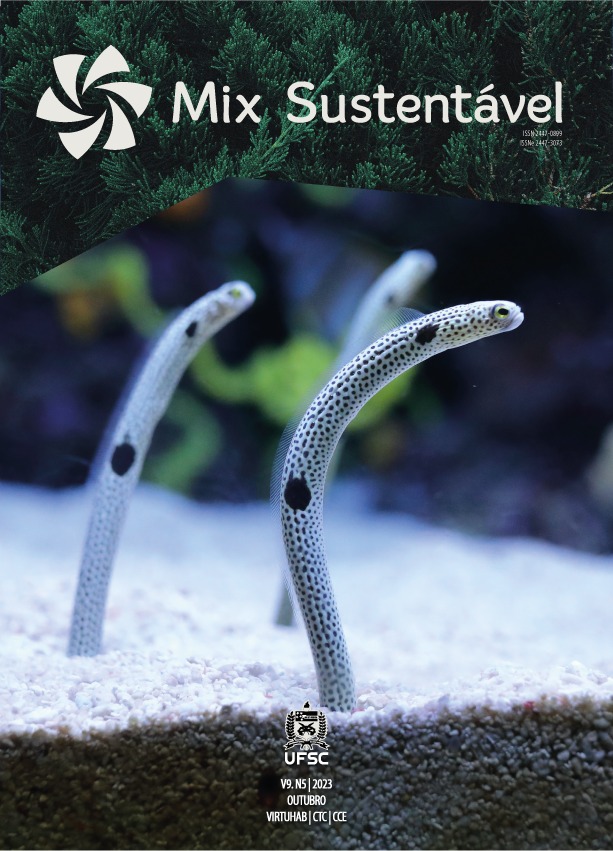INITIAL DEVELOPMENT OF Acacia mearnsii ON SUBSTRATE CONTAINING BIOCHAR DERIVED FROM CHARCOAL FINES
DESENVOLVIMENTO INICIAL DE Acacia mearnsii EM SUBSTRATO CONTENDO BIOCARVÃO DERIVADO DE FINOS DE CARVÃO VEGETAL
DOI:
https://doi.org/10.29183/2447-3073.MIX2023.v9.n5.115-124Keywords:
Biomass, Pyrolysis, Growing mediaAbstract
The objective of this research was to evaluate the cultivation performance using a substrate with addition of charcoal fines (CF). The methodology started with treatment of the CF in a mill to reduce the particle size to ≤ 2.5 mm mesh, to be later used to compose the treatments to be used in the substrate composition for Acacia mearnsii De Wild seedlings. The substrate used in the study for mixing was a commercial substrate based on peat, vermiculite, and limestone. For this, different ratios of substrate: CF mixture (100:0%, 95:5%, 75:25%, 50:50% and 25:75% (v:v)) were used. The analyzed parameters were density, pH, electrical conductivity, total content of soluble salts, water retention at 10, 50 and 100 hPa, total porosity, aeration space, easily available water and buffering water. The development of the species was evaluated based on phytometry, the parameters assessed were the number of leaves, height of the shoot, root length, fresh mass, and dry mass of the plant. The results showed that the substrate with CF presents different physical and chemical characteristics when compared to the substrate without CF, acting in a positive way for the development of the seedlings when added in a ratio of 95:5% (v:v).
References
Álvarez JM, Pasian C, Lal R, López R, Díaz MJ, Fernández M. (2018) Morpho-physiological plant quality when biochar and vermicompost are used as growing media replacement in urban horticulture. Urban For Urban Green.34:175-80.
Bailey, D. A., Nelson, P. V., & Fonteno, W. C. (2005). Substrate pH and Water Quality. Raleigh: North Caroline State University.
Blanco-Canqui H. (2017). Biochar and Soil Physical Properties. Soil Science Society of America Journal. 81:687-711.
BRASIL. Ministry of Agriculture, Livestock and Supply - MAPA Secretariat of Agricultural Defense. Normative Instruction No. 17, of May 21, 2007. Diário Oficial da República Federativa do Brasil.1:8).
Brassard P, Godbout S, Raghavan V. (2016). Soil biochar amendment as a climate change mitigation tool: Key parameters and mechanisms involved. Journal of Environmental Management. 181:484-97.
De Boodt, M., & Verdonck, O. (1972). The physical properties of the substrates in horticulture. Acta Horticulturae, 26:37–44.
Ding Y, Liu Y, Liu S, Li Z, Tan X, Huang X, Zeng G, Zhou L, Zheng B. (2016) Biochar to improve soil fertility. A review. Agronomy for Sustainable Development.36:1-18.
Elzobair KA, Stromberger ME, Ippolito JA, Lentz RD. (2015). Contrasting effects of biochar versus manure on soil microbial communities and enzyme activities in an Aridisol. Chemosphere. 142:145-52.
Enders A, Hanley K, Whitman T, Joseph S, Lehmann J. (2012). Characterization of biochars to evaluate recalcitrance and agronomic performance. Bioresource Technology. 114:644-53.
Fascella G, D’Angiolillo F, Ruberto G, Napoli E. (2020). Agronomic performance, essential oils and hydrodistillation wastewaters of Lavandula angustifolia grown on biochar-based substrates. Industrial Crops and Products. 154:112-133.
Glaser B, Lehmann J, Zech W. (2002). Ameliorating physical and chemical properties of highly weathered soils in the tropics with charcoal - A review. Biology and Fertility of Soils. 35:219-30.
Hoffmann, G. (1970). Verbindliche Methoden zur Untersuchung von TKS und Gartnerischen Erden. Mitteilubngen der VDLUFA. Heft. 6: 129-153.
Huang L, Gu M. (2019). Effects of biochar on container substrate properties and growth of plants—a review. Horticulture. 5:1-25.
IBGE. (2021). Production of Plant Extraction and Silviculture. Rio de Janeiro. 36.
Kämpf, A. N. Commercial Production of Ornamental Plants. (2000). Guaíba. Agricultural.
Kiehl, E. J. (1979). Manual of Edaphobiology: Soil-plant relations. São Paulo. Ceres
Laird DA. (2008). The Charcoal Vision: A Win-Win-Win Scenario for Simultaneously Producing Bioenergy, Permanently Sequestering Carbon, while Improving Soil and Water Quality. Agronomy Journal. 100:178-81.
Lehmann J, Rillig MC, Thies J, Masiello CA, Hockaday WC, Crowley D. (2011). Biochar effects on soil biota - A review. Soil Biology & Biochemistry. 43:1812-36.
Monteiro AB, Bamberg AL, Pereira IDS, Stöcker CM, Timm LC. (2021). Agronomic performance and optimal ranges of attributes of substrates with biochar from anaerobic sewage sludge for black wattle (Acacia mearnsii) seedlings. International Journal of Recycling of Organic Waste in Agriculture. 10:297-308.
Nieto A, Gascó G, Paz-Ferreiro J, Fernández JM, Plaza C, Méndez A. (2016) The effect of pruning waste and biochar addition on brown peat based growing media properties. Scientia Horticulturae (Amsterdam). 199:142-8.
Nobile C, Denier J, Houben D. (2020) Linking biochar properties to biomass of basil, lettuce and pansy cultivated in growing media. Scientia Horticulturae (Amsterdam).261.
Pinheiro, P.C.C.; Sampaio, R.S.; Rezende, M.E.A.; Viana, E.A. (2006) The production of charcoal: theory and practice. Belo Horizonte.
Röber, R., Schaller, K. (1985). Pflanzenernahrung im gartenbau. Stuttgart Ulmer.
São José JFB, Volpiano CG, Vargas LK, Hernandes MAS, Lisboa BB, Schlindwein G, Beneduzi A, Longoni LS, Sampaio Jat. (2019). Influence of hot water on breaking painmancy, incubation temperature and rhizobial inoculation on germination of Acacia mearnsii seeds. Australian Forestry. 82:157-61.
Smith JL, Collins HP, Bailey VL. (2010). The effect of young biochar on soil respiration. Soil Biology & Biochemistry. 42:2345-7.
UNE - Asociación Española de Normalización. Standard EN 13037. Mejoradores del suelo y medios de cultivation. La determinación del pH. Bruxelles: Comité Europeén de Normalisation, 2012.
Waller, P. L.; Wilson, G. C. S. (1984). Evaluation of growing media for consumer use. Acta Horticulturae. 150:51-58.
Woolf D, Amonette JE, Street-Perrott FA, Lehmann J, Joseph S. (2010). Sustainable biochar to mitigate global climate change. Nature Communications. 1-1-9.
Yan J, Yu P, Liu C, Li Q, Gu M. (2020) Replacing peat moss with mixed hardwood biochar as container substrates to produce five types of mint (Mentha spp.). Industrial Crops and Products.
Downloads
Published
How to Cite
Issue
Section
License
Copyright (c) 2023 Marina Remião dos Santos, Igor Glaeser da Rocha, Juliano Morales de Oliveira, Gilson Schlindwein, Carlos Alberto Mendes Moraes, Genyr Kappler, Regina Celia Espinosa Modolo

This work is licensed under a Creative Commons Attribution 4.0 International License.
Creative Commons Copyright Notice
Attribution 4.0 International




